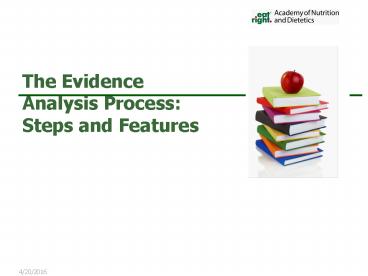The Evidence Analysis Process: Steps and Features PowerPoint PPT Presentation
Title: The Evidence Analysis Process: Steps and Features
1
- The Evidence Analysis Process Steps and Features
2
Presentation Objectives
- Understand the Steps in the Academy of Nutrition
and Dietetics Evidence Analysis Process - Identify topics and features in the Academys
Evidence Analysis Library
3
Evidence Analysis Library
FREE to Academy Members!
www.andevidencelibrary.com Online resource with
the best available research on important dietetics
topics in a practitioner-friendly format
4
Definition
- Evidence-Based Dietetics Practice
- is the use of systematically reviewed scientific
evidence in making food and nutrition practice
decisions - by integrating best available evidence with
professional expertise and client values to
improve outcomes.
Definition developed by A.N.D. Evidence-based
Practice Committee with input from Research
Committee, Quality Management Committee, and
Scope of Dietetics Practice Task Force. Approved
by A.N.D. House of Delegates Leadership Team
5
Why Evidence-Based?
- Improve quality of healthcare
- Decrease wide variations in practice
- Reduce the gap between what is known from
researchand what happens in real life - Take advantage of biomedical knowledge
6
Evidence-Based Practice Committee
7
Structure of EBP Committee
- Joint Academy House of Delegates Board of
Directors appointed committee
8
Academys Evidence Analysis Process
- A rigorous and systematic process for
searching, analyzing and summarizing research on
a specific nutrition topic.
9
Evidence Analysis Workgroup
10
Project Managers/Lead Analysts
11
Steps in the Evidence Analysis Process
12
- Step 1
- Formulate the Question
13
Formulate the Question
- We ask questions to
14
Nutrition Care Process
Nutrition Assessment
Nutrition Diagnosis
Nutrition Intervention
What do you do at each step in the nutrition care
process? Evidence analysis should focus on
answering questions related to these steps.
Nutrition Monitoring And Evaluation Outcomes
15
Example Question
16
- Step 2
- Gather and Classify the Research
17
Search Plan Results for Each Question
Reports Inclusion Exclusion Criteria
Date of Search Inclusion Criteria -Age -Setting
(outpatient) -Sample Size -Acceptable dropout
rate -Year Range -English Language Databases
Searched Search Terms List of Articles
18
Search Plan Results
- Included articles and Excluded articles (with
reason)
List reason for exclusion for each article
not included in the analysis e.g. Sample size
too small
19
- Step 3
- Critically Appraise Each Article
20
Worksheet
Citation / PubMed ID Date Study
Design Class Rating (/0/-) Research
Purpose Inclusion Criteria Exclusion
Criteria Description of Study Protocol Data
Collection Summary Description of Actual Data
Sample Summary of Results Author
Conclusion Reviewer Comments
21
Quality Criteria Checklist
Questions related to relevance and
validity Determines if article is rated
as Positive Quality Negative Quality Neutral
Quality
22
- Step 4
- Summarize the Evidence in an Overview table and
Evidence Summary
23
Narrative Evidence Summary
Example Summary of evidence for Oats and Gluten
Intolerance question
24
Overview Table
- List
- Citation
- Study Design
- Quality Rating
- Sample Size
- Interventions Outcomes
- Table format to enable user to compare studies
side by side.
25
Evidence Summary - Bibliography
Citations linked to worksheets at the bottom of
the Evidence Summary
26
- Step 5
- Develop Conclusion Statement and Grade the
Strength of the Supporting Evidence
27
Conclusion Statement
28
Explanation of Grades
of Grade I questions on EAL
29
Published on the EAL
- Available free to All Academy Members
- Question
- Conclusion
- Grade
- Evidence Summary
- Overview Table
- Worksheets and Quality Checklists for each
article - Search Plan Results
- Individual EAL Subscriptions are available from
www.andevidencelibrary.com / Store - For Institutional EAL subscriptions, contact
aacosta_at_eatright.org
30
How Much Content is on the EAL?
- Abstracted Articles/Worksheets
115
31
EAL Page Views by Calendar Year
Calendar Year Total Avg per Month
2004 41,332 4,592
2005 378,026 31,502
2006 1,068,758 89,063
2007 1,544,119 128,677
2008 1,795,645 171,014
2009 2,321,594 193.466
2010 2,457,410 204,784
2011 3,009,230 250,645
2012 3,804,122 317,518
2013 (thru 9/30) 2,580,540 286,700
Overall Total Sept 2004 Oct 2013 Over
17,914,000 page views
32
EAL Usage Worldwide
- Users from 206 different countries
33
NutriGuides
- On the Go with NutriGuides Mobile Application
- Now available for use on your iPhone, iPad, and
Android devices. - Users can access over 300 nutrition
recommendations at their fingertips. - Ability to search for recommendation by topic,
disease/condition, nutrition care process step - Topics include Diabetes, Critical Illness,
Celiac Disease, DLM, and more! - Debuted in March 2012. Now nearly 5,000 apps
sold from the iTunes Store and Google Play.
34
Guideline Development
35
Evidence-Based Nutrition Practice Guidelines
- Evidence-Based Guidelines
- A series of guiding statements and treatment
algorithms - Developed using a systematic process
- Assist the practitioner in decision making for
appropriate nutrition care
36
Evidence-Based Practice Resources
- What are Evidence-Based Toolkits?
- Toolkits are disease specific and include
- Protocol forms
- Case Studies
- Patient progress forms
- Outcomes management forms
- Client education resources
- Incorporate the Nutrition Care Process
- Electronic downloadable purchase item
37
Toolkit Development
38
Steps in the EA Process
- Annual review of Evidence Analysis Guideline
Projects - Review
- Re-run searches for each question
- Determine if revision is needed
- Document date of review
- Revise
- Revise using EA Process
- Update rating of conclusion
- statements/recommendations as needed
39
Summary
- Academys Evidence Analysis Library can be found
at www.andaevidencelibrary.com - Questions contact eal_at_andevidencelibrary.com

